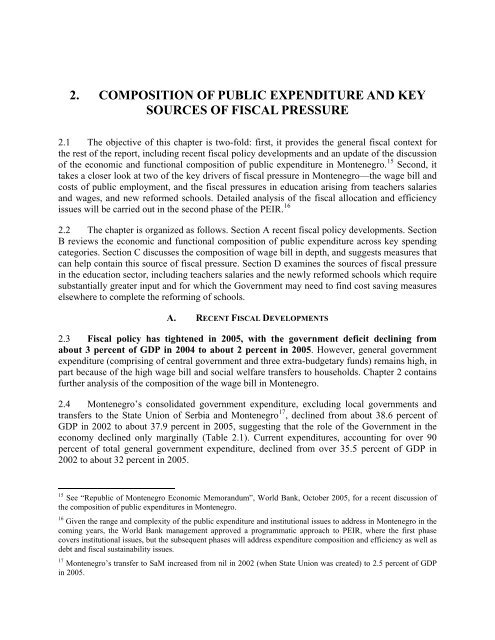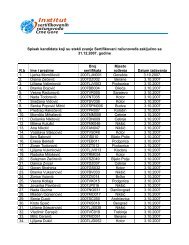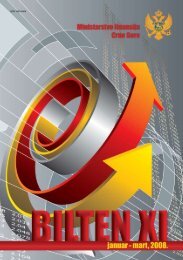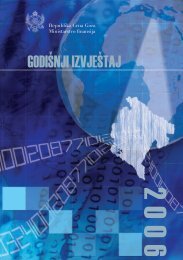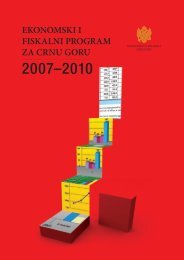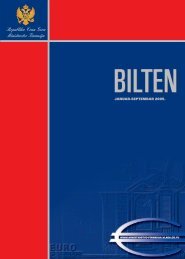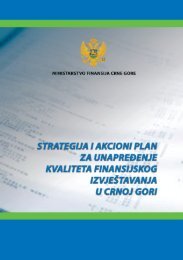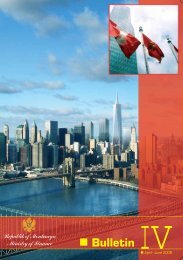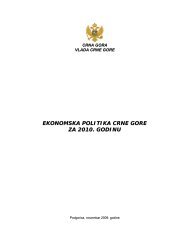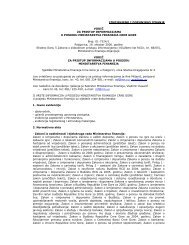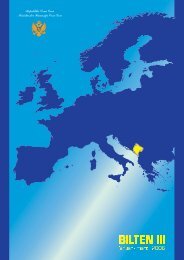Republic of Montenegro: Public Expenditure and ... - Vlada Crne Gore
Republic of Montenegro: Public Expenditure and ... - Vlada Crne Gore
Republic of Montenegro: Public Expenditure and ... - Vlada Crne Gore
Create successful ePaper yourself
Turn your PDF publications into a flip-book with our unique Google optimized e-Paper software.
2. COMPOSITION OF PUBLIC EXPENDITURE AND KEY<br />
SOURCES OF FISCAL PRESSURE<br />
2.1 The objective <strong>of</strong> this chapter is two-fold: first, it provides the general fiscal context for<br />
the rest <strong>of</strong> the report, including recent fiscal policy developments <strong>and</strong> an update <strong>of</strong> the discussion<br />
<strong>of</strong> the economic <strong>and</strong> functional composition <strong>of</strong> public expenditure in <strong>Montenegro</strong>. 15 Second, it<br />
takes a closer look at two <strong>of</strong> the key drivers <strong>of</strong> fiscal pressure in <strong>Montenegro</strong>—the wage bill <strong>and</strong><br />
costs <strong>of</strong> public employment, <strong>and</strong> the fiscal pressures in education arising from teachers salaries<br />
<strong>and</strong> wages, <strong>and</strong> new reformed schools. Detailed analysis <strong>of</strong> the fiscal allocation <strong>and</strong> efficiency<br />
issues will be carried out in the second phase <strong>of</strong> the PEIR. 16<br />
2.2 The chapter is organized as follows. Section A recent fiscal policy developments. Section<br />
B reviews the economic <strong>and</strong> functional composition <strong>of</strong> public expenditure across key spending<br />
categories. Section C discusses the composition <strong>of</strong> wage bill in depth, <strong>and</strong> suggests measures that<br />
can help contain this source <strong>of</strong> fiscal pressure. Section D examines the sources <strong>of</strong> fiscal pressure<br />
in the education sector, including teachers salaries <strong>and</strong> the newly reformed schools which require<br />
substantially greater input <strong>and</strong> for which the Government may need to find cost saving measures<br />
elsewhere to complete the reforming <strong>of</strong> schools.<br />
A. RECENT FISCAL DEVELOPMENTS<br />
2.3 Fiscal policy has tightened in 2005, with the government deficit declining from<br />
about 3 percent <strong>of</strong> GDP in 2004 to about 2 percent in 2005. However, general government<br />
expenditure (comprising <strong>of</strong> central government <strong>and</strong> three extra-budgetary funds) remains high, in<br />
part because <strong>of</strong> the high wage bill <strong>and</strong> social welfare transfers to households. Chapter 2 contains<br />
further analysis <strong>of</strong> the composition <strong>of</strong> the wage bill in <strong>Montenegro</strong>.<br />
2.4 <strong>Montenegro</strong>’s consolidated government expenditure, excluding local governments <strong>and</strong><br />
transfers to the State Union <strong>of</strong> Serbia <strong>and</strong> <strong>Montenegro</strong> 17 , declined from about 38.6 percent <strong>of</strong><br />
GDP in 2002 to about 37.9 percent in 2005, suggesting that the role <strong>of</strong> the Government in the<br />
economy declined only marginally (Table 2.1). Current expenditures, accounting for over 90<br />
percent <strong>of</strong> total general government expenditure, declined from over 35.5 percent <strong>of</strong> GDP in<br />
2002 to about 32 percent in 2005.<br />
15 See “<strong>Republic</strong> <strong>of</strong> <strong>Montenegro</strong> Economic Memor<strong>and</strong>um”, World Bank, October 2005, for a recent discussion <strong>of</strong><br />
the composition <strong>of</strong> public expenditures in <strong>Montenegro</strong>.<br />
16 Given the range <strong>and</strong> complexity <strong>of</strong> the public expenditure <strong>and</strong> institutional issues to address in <strong>Montenegro</strong> in the<br />
coming years, the World Bank management approved a programmatic approach to PEIR, where the first phase<br />
covers institutional issues, but the subsequent phases will address expenditure composition <strong>and</strong> efficiency as well as<br />
debt <strong>and</strong> fiscal sustainability issues.<br />
17 <strong>Montenegro</strong>’s transfer to SaM increased from nil in 2002 (when State Union was created) to 2.5 percent <strong>of</strong> GDP<br />
in 2005.


